:max_bytes(150000):strip_icc():format(webp)/football-referee-signaling-touchdown-in-stadium-599944339-5a84cb9e875db900367df025.jpg)
Updated 2024 Approved S Top-Rated Free AVI Video Rotation Software Revealed

‘S Top-Rated Free AVI Video Rotation Software Revealed
Top 5 Best Free AVI Video Rotators

Ollie Mattison
Mar 27, 2024• Proven solutions
Rotating the audio and video files is quite a challenging task though, but the arrival of some of the well known video rotators has solved this problem. However, there are numbers of video rotating software programs that support multiple audio and video file formats; the current article covers the video rotating tools that support the AVI file formats along with many others. Given below is the list of efficient AVI video rotators that are available free of cost.
- Avidemux
- Video Rotator
- Free Video Flip and Rotate
- Freemake Video Converter
- Any Video Converter
- Recommended: Wondershare Filmora (originally Wondershare Video Editor)
#1. Avidemux
Besides cutting and filtering video files, Avidemux allows the users to flip and rotate the video file with ease. It supports popular video formats like MPEG, AVI, WMV, MOV and many more. It allows the user to set audio codec, video dimension and quality to get the desired output. Avidemux has made it’s easier to add a video file and make changes using various options available in the menu tab.
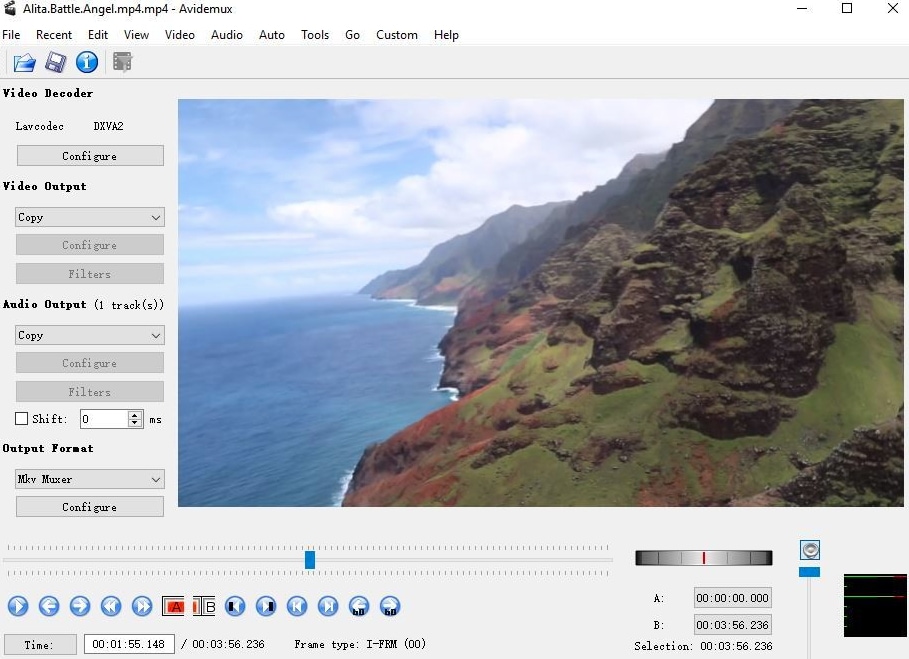
Pros:
- Useful presets for common output tasks;
- Different video editing functions.
Cons:
- Outdated interface.
#2. Video Rotator
Video rotator is easy to use software that offers a particular task to perform which is none other than video rotation. The user can easily use its drag and drop menu to select and rotate the video. It takes multiple video formats as input and produces output in the specified format. It fixes the orientation and preserves high video quality.
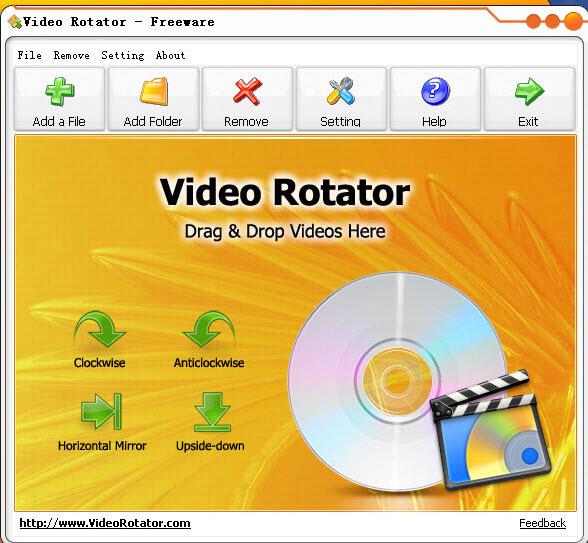
Pros:
- Facilitates batch processing;
- User friendly interface;
- A compact video rotating tool;
- Also works as an efficient video converter.
Cons:
- Crashed occasionally;
- Few editing controls.
#3. Free Video Flip and Rotate
Free video flip and rotate is a handy application that allows he users to rotate the video files in multiple formats like AVI, WMV and MPG. However, it takes input files in multiple formats but supports only AVI format as output. It has a preview screen that offers various playback buttons on it. The user can use this software individually or can also install applications suite free of cost.
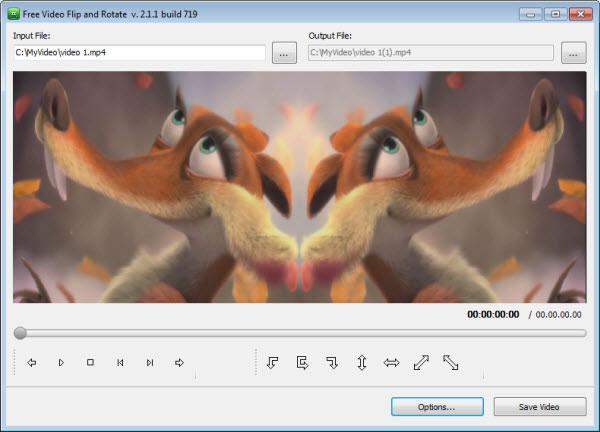
Pros:
- Easy to Use;
- Lightweight;
- Offers compatibility.
Cons:
- Cannot create presets;
- AVI output only.
#4. Freemake Video Converter
This software includes different video editing features that can rotate MPG, ASF, WMV and AVI files in a convenient manner. It enables the users to rotate the video at any degree they want to rotate the file; they can save the file using either same or different file name. Direct video rotate functionalities are available for both compressed and uncompressed AVI files.

Pros:
- Easy & intuitive to Use;
- Simple features;
- Impressive number of video formats.
Cons:
- Limited editing abilities;
- Few Extra Features.
#5. Any Video Converter
Any Video Converter is a compatible tool that supports different video formats including AVI, MOV, MPG and WMV files. It is recognized as one of the most useful video rotating software that comes with many features including the choice of rotation; it enables the users to rotate the file at 90, 180 ad 270 degrees with ease. Its user friendly interface and quality output have attracted the users in an efficient and effective manner.
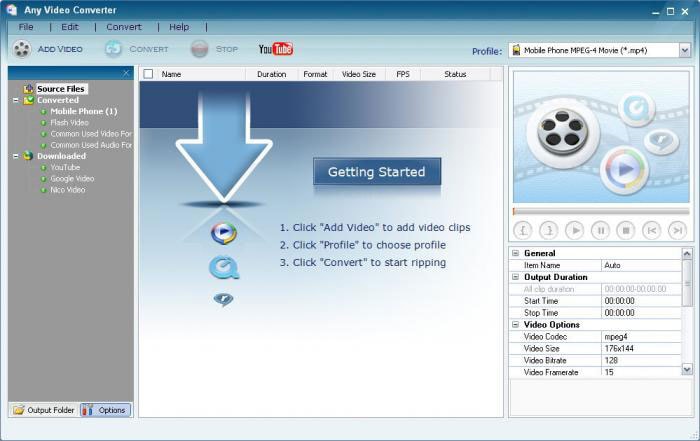
Pros:
- Supports almost any video formats;
- Different video editing functions.
Cons:
- Can’t convert audio files.
Recommended: Wondershare Filmora (originally Wondershare Video Editor)
If you want to rotate different types of video files video editor,Wondershare Filmora is a great choice. Just place the video files on the timeline and then you can rotate your videos 90 degrees clockwise or anticlockwise or spin them vertically and horizontally.
 Download Mac Version ](https://tools.techidaily.com/wondershare/filmora/download/ )
Download Mac Version ](https://tools.techidaily.com/wondershare/filmora/download/ )

Ollie Mattison
Ollie Mattison is a writer and a lover of all things video.
Follow @Ollie Mattison
Ollie Mattison
Mar 27, 2024• Proven solutions
Rotating the audio and video files is quite a challenging task though, but the arrival of some of the well known video rotators has solved this problem. However, there are numbers of video rotating software programs that support multiple audio and video file formats; the current article covers the video rotating tools that support the AVI file formats along with many others. Given below is the list of efficient AVI video rotators that are available free of cost.
- Avidemux
- Video Rotator
- Free Video Flip and Rotate
- Freemake Video Converter
- Any Video Converter
- Recommended: Wondershare Filmora (originally Wondershare Video Editor)
#1. Avidemux
Besides cutting and filtering video files, Avidemux allows the users to flip and rotate the video file with ease. It supports popular video formats like MPEG, AVI, WMV, MOV and many more. It allows the user to set audio codec, video dimension and quality to get the desired output. Avidemux has made it’s easier to add a video file and make changes using various options available in the menu tab.

Pros:
- Useful presets for common output tasks;
- Different video editing functions.
Cons:
- Outdated interface.
#2. Video Rotator
Video rotator is easy to use software that offers a particular task to perform which is none other than video rotation. The user can easily use its drag and drop menu to select and rotate the video. It takes multiple video formats as input and produces output in the specified format. It fixes the orientation and preserves high video quality.

Pros:
- Facilitates batch processing;
- User friendly interface;
- A compact video rotating tool;
- Also works as an efficient video converter.
Cons:
- Crashed occasionally;
- Few editing controls.
#3. Free Video Flip and Rotate
Free video flip and rotate is a handy application that allows he users to rotate the video files in multiple formats like AVI, WMV and MPG. However, it takes input files in multiple formats but supports only AVI format as output. It has a preview screen that offers various playback buttons on it. The user can use this software individually or can also install applications suite free of cost.

Pros:
- Easy to Use;
- Lightweight;
- Offers compatibility.
Cons:
- Cannot create presets;
- AVI output only.
#4. Freemake Video Converter
This software includes different video editing features that can rotate MPG, ASF, WMV and AVI files in a convenient manner. It enables the users to rotate the video at any degree they want to rotate the file; they can save the file using either same or different file name. Direct video rotate functionalities are available for both compressed and uncompressed AVI files.

Pros:
- Easy & intuitive to Use;
- Simple features;
- Impressive number of video formats.
Cons:
- Limited editing abilities;
- Few Extra Features.
#5. Any Video Converter
Any Video Converter is a compatible tool that supports different video formats including AVI, MOV, MPG and WMV files. It is recognized as one of the most useful video rotating software that comes with many features including the choice of rotation; it enables the users to rotate the file at 90, 180 ad 270 degrees with ease. Its user friendly interface and quality output have attracted the users in an efficient and effective manner.

Pros:
- Supports almost any video formats;
- Different video editing functions.
Cons:
- Can’t convert audio files.
Recommended: Wondershare Filmora (originally Wondershare Video Editor)
If you want to rotate different types of video files video editor,Wondershare Filmora is a great choice. Just place the video files on the timeline and then you can rotate your videos 90 degrees clockwise or anticlockwise or spin them vertically and horizontally.
 Download Mac Version ](https://tools.techidaily.com/wondershare/filmora/download/ )
Download Mac Version ](https://tools.techidaily.com/wondershare/filmora/download/ )

Ollie Mattison
Ollie Mattison is a writer and a lover of all things video.
Follow @Ollie Mattison
Ollie Mattison
Mar 27, 2024• Proven solutions
Rotating the audio and video files is quite a challenging task though, but the arrival of some of the well known video rotators has solved this problem. However, there are numbers of video rotating software programs that support multiple audio and video file formats; the current article covers the video rotating tools that support the AVI file formats along with many others. Given below is the list of efficient AVI video rotators that are available free of cost.
- Avidemux
- Video Rotator
- Free Video Flip and Rotate
- Freemake Video Converter
- Any Video Converter
- Recommended: Wondershare Filmora (originally Wondershare Video Editor)
#1. Avidemux
Besides cutting and filtering video files, Avidemux allows the users to flip and rotate the video file with ease. It supports popular video formats like MPEG, AVI, WMV, MOV and many more. It allows the user to set audio codec, video dimension and quality to get the desired output. Avidemux has made it’s easier to add a video file and make changes using various options available in the menu tab.

Pros:
- Useful presets for common output tasks;
- Different video editing functions.
Cons:
- Outdated interface.
#2. Video Rotator
Video rotator is easy to use software that offers a particular task to perform which is none other than video rotation. The user can easily use its drag and drop menu to select and rotate the video. It takes multiple video formats as input and produces output in the specified format. It fixes the orientation and preserves high video quality.

Pros:
- Facilitates batch processing;
- User friendly interface;
- A compact video rotating tool;
- Also works as an efficient video converter.
Cons:
- Crashed occasionally;
- Few editing controls.
#3. Free Video Flip and Rotate
Free video flip and rotate is a handy application that allows he users to rotate the video files in multiple formats like AVI, WMV and MPG. However, it takes input files in multiple formats but supports only AVI format as output. It has a preview screen that offers various playback buttons on it. The user can use this software individually or can also install applications suite free of cost.

Pros:
- Easy to Use;
- Lightweight;
- Offers compatibility.
Cons:
- Cannot create presets;
- AVI output only.
#4. Freemake Video Converter
This software includes different video editing features that can rotate MPG, ASF, WMV and AVI files in a convenient manner. It enables the users to rotate the video at any degree they want to rotate the file; they can save the file using either same or different file name. Direct video rotate functionalities are available for both compressed and uncompressed AVI files.

Pros:
- Easy & intuitive to Use;
- Simple features;
- Impressive number of video formats.
Cons:
- Limited editing abilities;
- Few Extra Features.
#5. Any Video Converter
Any Video Converter is a compatible tool that supports different video formats including AVI, MOV, MPG and WMV files. It is recognized as one of the most useful video rotating software that comes with many features including the choice of rotation; it enables the users to rotate the file at 90, 180 ad 270 degrees with ease. Its user friendly interface and quality output have attracted the users in an efficient and effective manner.

Pros:
- Supports almost any video formats;
- Different video editing functions.
Cons:
- Can’t convert audio files.
Recommended: Wondershare Filmora (originally Wondershare Video Editor)
If you want to rotate different types of video files video editor,Wondershare Filmora is a great choice. Just place the video files on the timeline and then you can rotate your videos 90 degrees clockwise or anticlockwise or spin them vertically and horizontally.
 Download Mac Version ](https://tools.techidaily.com/wondershare/filmora/download/ )
Download Mac Version ](https://tools.techidaily.com/wondershare/filmora/download/ )

Ollie Mattison
Ollie Mattison is a writer and a lover of all things video.
Follow @Ollie Mattison
Ollie Mattison
Mar 27, 2024• Proven solutions
Rotating the audio and video files is quite a challenging task though, but the arrival of some of the well known video rotators has solved this problem. However, there are numbers of video rotating software programs that support multiple audio and video file formats; the current article covers the video rotating tools that support the AVI file formats along with many others. Given below is the list of efficient AVI video rotators that are available free of cost.
- Avidemux
- Video Rotator
- Free Video Flip and Rotate
- Freemake Video Converter
- Any Video Converter
- Recommended: Wondershare Filmora (originally Wondershare Video Editor)
#1. Avidemux
Besides cutting and filtering video files, Avidemux allows the users to flip and rotate the video file with ease. It supports popular video formats like MPEG, AVI, WMV, MOV and many more. It allows the user to set audio codec, video dimension and quality to get the desired output. Avidemux has made it’s easier to add a video file and make changes using various options available in the menu tab.

Pros:
- Useful presets for common output tasks;
- Different video editing functions.
Cons:
- Outdated interface.
#2. Video Rotator
Video rotator is easy to use software that offers a particular task to perform which is none other than video rotation. The user can easily use its drag and drop menu to select and rotate the video. It takes multiple video formats as input and produces output in the specified format. It fixes the orientation and preserves high video quality.

Pros:
- Facilitates batch processing;
- User friendly interface;
- A compact video rotating tool;
- Also works as an efficient video converter.
Cons:
- Crashed occasionally;
- Few editing controls.
#3. Free Video Flip and Rotate
Free video flip and rotate is a handy application that allows he users to rotate the video files in multiple formats like AVI, WMV and MPG. However, it takes input files in multiple formats but supports only AVI format as output. It has a preview screen that offers various playback buttons on it. The user can use this software individually or can also install applications suite free of cost.

Pros:
- Easy to Use;
- Lightweight;
- Offers compatibility.
Cons:
- Cannot create presets;
- AVI output only.
#4. Freemake Video Converter
This software includes different video editing features that can rotate MPG, ASF, WMV and AVI files in a convenient manner. It enables the users to rotate the video at any degree they want to rotate the file; they can save the file using either same or different file name. Direct video rotate functionalities are available for both compressed and uncompressed AVI files.

Pros:
- Easy & intuitive to Use;
- Simple features;
- Impressive number of video formats.
Cons:
- Limited editing abilities;
- Few Extra Features.
#5. Any Video Converter
Any Video Converter is a compatible tool that supports different video formats including AVI, MOV, MPG and WMV files. It is recognized as one of the most useful video rotating software that comes with many features including the choice of rotation; it enables the users to rotate the file at 90, 180 ad 270 degrees with ease. Its user friendly interface and quality output have attracted the users in an efficient and effective manner.

Pros:
- Supports almost any video formats;
- Different video editing functions.
Cons:
- Can’t convert audio files.
Recommended: Wondershare Filmora (originally Wondershare Video Editor)
If you want to rotate different types of video files video editor,Wondershare Filmora is a great choice. Just place the video files on the timeline and then you can rotate your videos 90 degrees clockwise or anticlockwise or spin them vertically and horizontally.
 Download Mac Version ](https://tools.techidaily.com/wondershare/filmora/download/ )
Download Mac Version ](https://tools.techidaily.com/wondershare/filmora/download/ )

Ollie Mattison
Ollie Mattison is a writer and a lover of all things video.
Follow @Ollie Mattison
Smooth Operator: 3 Techniques to Stabilize Footage in AE
Stabilize Shaky Videos After Recording Easily
Wondershare Filmora is one of the most popular video editing software among YouTubers , which provides the video stabilization tool to remove shake from videos within one-click. Download and have a try now.
Video content is becoming increasingly popular; with the proliferation of online content, practically every product now needs its mini-documentary or video clip. Experienced filmmakers and VFX artists used to be the only ones who could get smooth footage. Those days, however, are over.
Adobe After Effects is an excellent tool for smoothing out video footage, in addition to being a great blending and motion animation software; although it’s usually preferable to maintain your film as seamless as possible on location, it’s not the end of the world if you take a seat to edit your video and decide it’s too shaky. In truth, there are several options available to you. In After Effects, there are three options for stabilizing footage. What are they – and how to use After Effects to stabilize footage? Let’s find out!
In this article
01 Stabilize Video with Built-in Warp Stabilizer in AE
02 Stabilize Shaky Video with Track Motion Feature in AE
03 Using Stabilization Plugins for Smoother Video in AE
Part 1: Stabilize Video with Built-in Warp Stabilizer in AE
The Warp Stabilizer effect is a new technique to cope with unsteady video. In this part, I will show you how to apply Warp Stabilizer to a layer, adjust the effect’s essential parameters, and demonstrate how they work briefly.
Step 1: The Warp Stabilizer is the most excellent built-in choice for After Effects. This may be found under the Distort tools section of the Effects & Presets panel. You may also go to the effects tab and look for “Warp“ in the search box.
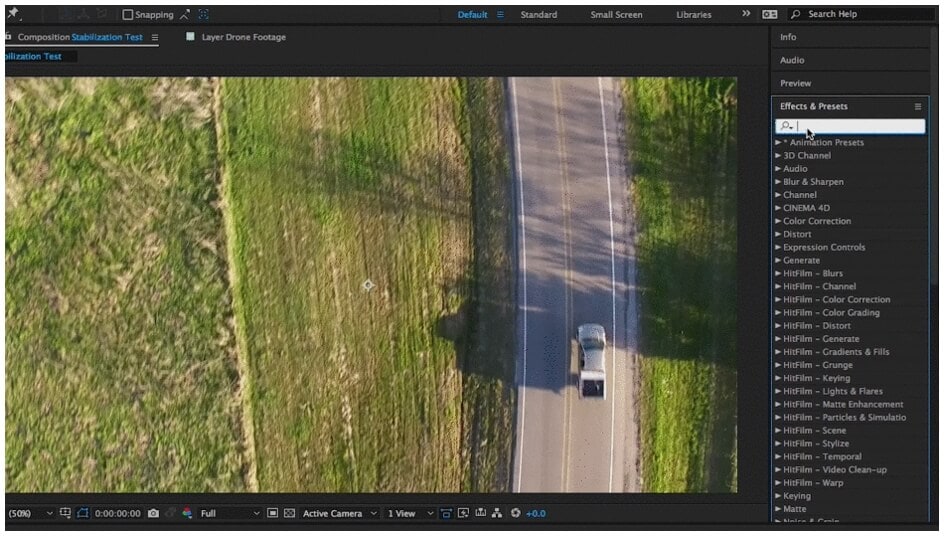
Step 2: When you’ve identified Warp Stabilizer, you’ll have to add it to the layer you want to stabilize. You may accomplish this in one of three different ways. You may either drag and drop the filter into the chosen layer in the composing window, place it on the desired layer in the timeline, or double-tap on the effect while selecting your choice footage layer.
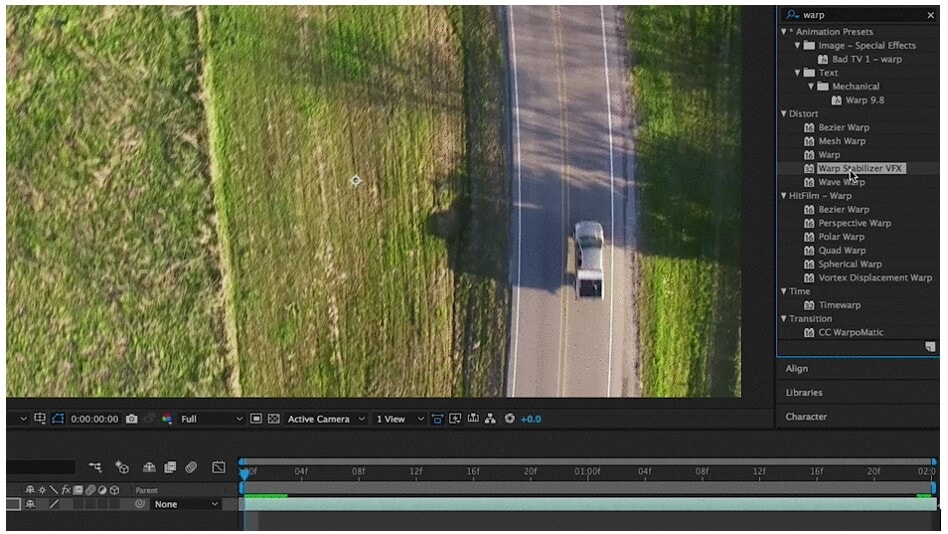
Step 3: Once you apply the warp stabilizer, it will start immediately. So now, all you have to do is lay back and let the stabilizer do its job.
(Note: The procedure should take no more than a few minutes, and a blue bar will appear across your composition window, indicating that the warp stabilizer is evaluating the film. The composition panel would then display an orange bar, indicating that the effect is applied).
Step 4: After stabilization, use the spacebar to begin a RAM peek. Choose the layer you added to and click to display the drop-down menu or go to the Effects Control panel whenever you need to tweak the stabilizing effect.
Part 2: Stabilize Shaky Video with Track Motion Feature in AE
Using Stabilize Motion feature to stabilize video is an old-school heritage function from the era of the Creative Suite, it will still be there in After Effects presently and performs admirably.
Step 1: The tracker panel is most likely open by default in your edition of After Effects, but if it isn’t, go to Window in the top menu to open it. Once you’ve arrived here, scroll to the bottom until you locate Tracker and double-check that it has a checkbox beside it.
![]()
Step 2: Select Stabilize Motion from the drop-down menu whenever the tracker panel is open. You’ll see that a tracker box appears in your Layer Panel once you’ve done this.
(Note: You’ll need to identify a proper location in your film for the tracker to operate at this stage. We’re monitoring a vehicle using a camera operator’s drone in the instance below).
![]()
Step 3: Let’s press the Play button on the tracker panel once we’ve set up the tracker box. The tracker box should adhere to the location or item you chose when you do this.
(Note: When your tracking points start to go astray, use the Pause button, personally modify the tracking point, and then push play to resume the journey).
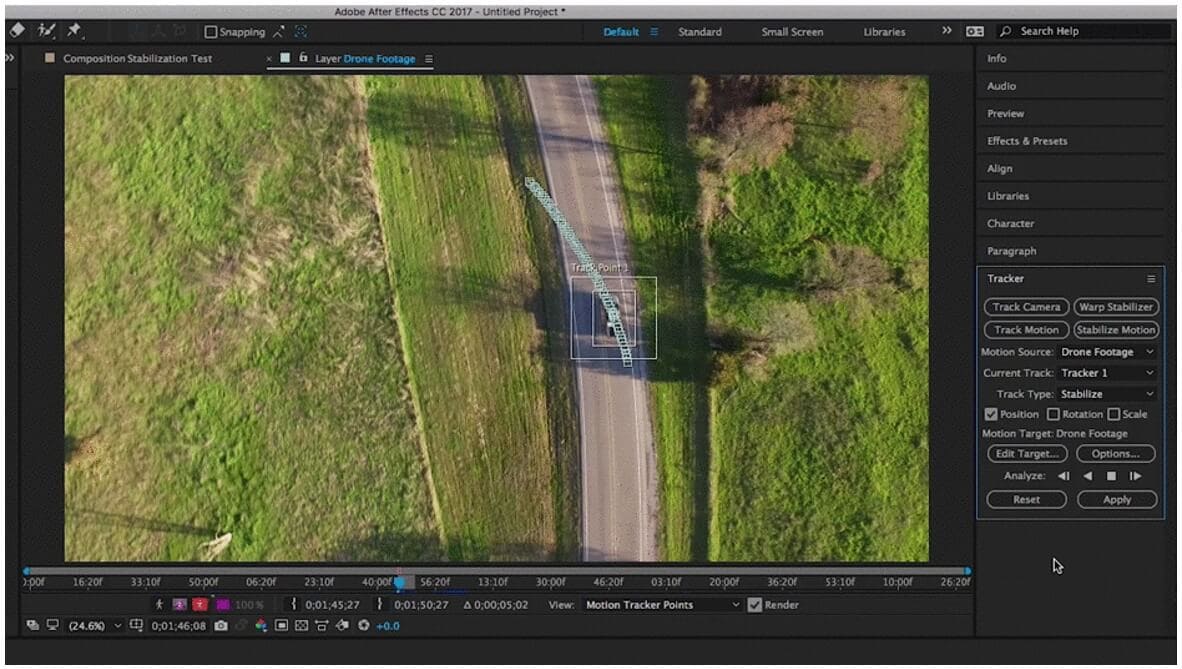
Step 4: When the tracker is done and satisfied with the results, click Edit target to verify that the tracking data is transferred to the correct layer. Then proceed to the bottom of the page and click the Apply option.
(Note A dialogue window with choices for applying them. Usually, you’ll want to choose X and Y here).
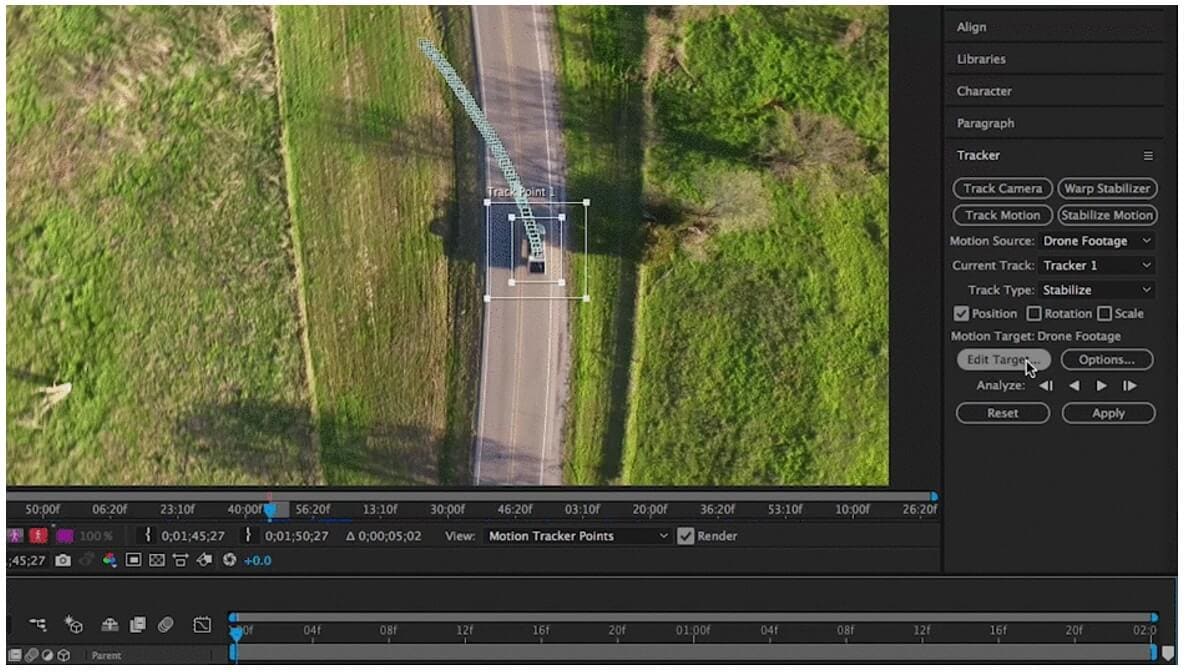
Hit the spacebar to evaluate how well the stabilize motion tracker performed now when you’re back in the composition window. When you’re not pleased with the outcomes, you might have to go back to try again. Although this approach is best used for photos with a clear point of focus that doesn’t go out of frame, it could still be helpful in some situations.
Part 3: Using Stabilization Plugins for Smoother Video in AE
As a graphic and motion designer, animator, or 3D artist, After Effects plugins may completely change the way you operate. Since it can handle so much right out of the box, Adobe After Effects CC is already a go-to motion graphic and compositing program for many artists.
However, as with any good program, third-party plugins could only help you take your work to the next level by adding new features or streamlining your process.
It should be unsurprising that After Effects has many plugins for a program that is over 30 years old. Here are the best stabilization plugins for smoother video in AE:
1. Orb
Orb is focused on generating realistic planets and includes a range of unique features to make planetary creation easy. It utilizes a similar 3D engine to Video Copilot’s great Element 3D plugin, and it employs a similar 3D engine to Video Copilot’s outstanding Element 3D plugin.
You would believe that making planets in 3D is simple —create a circle, add textures, and you’re done! Getting a world to ‘look’ properly, on the other hand, might be more complicated than it appears.
For example, how can the line between night and day be altered in a model of a populated planet such that cities may be visible at night but not during the day?
Although Orb doesn’t work for every planetary picture, this would function for 90% of them and is a helpful previs tool. This is particularly true when used in conjunction with other After Effects plugins or paired with a 3D lens from a 3D program, which may be brought into After Effects with background plates for things like spacecraft.
2. Depth of Field Generator PRO (DOF PRO)
Richard Rosenman’s renowned Photoshop depth of field generator plugin, DOF PRO (Depth of Field Generator PRO), is now downloadable for After Effects. DOF PRO has become the industry’s professional option for an unprecedented and complex depth of field effects rapidly and effectively as a post-process.
This is thanks to almost a decade of discovery and application since the first launch in 2005. DOF PRO’s cutting-edge characteristics offer new and advanced technologies not found anywhere else, resulting in one of the industry’s most potent and sophisticated depth of field processors.
Capability for chromatic and achromatic aberration, focal plane bokeh distinction, astigmatism and vignetting effects, bespoke aperture maps, and noise recovery are among the advanced features.
There will also be compatibility with the alpha channel and transparency, 32-bit floating-point color, correct aperture displays, and an iris array display. A feature comparison between the plugin and After Effects’ Camera Lens Blur effect can be found here.
3. ReelSteady
ReelSteady for After Effects is a recent addition to the stabilization marketplace. ReelSteady is similar to After Effects’ warp stabilizer plugin. However, the stabilization in ReelSteady is far superior.
ReelSteady also has several other features that make it ideal for creating next-level tunes. Users may design filters to block off specific sections of your frame. This is useful for removing a subject that travels around the frame a lot.
In terms of performance, the After Effects plugin is pretty similar to the warp stabilizer but with a few more features. To begin with, ReelSteady includes a built-in rolling shutter repair tool that operates in tandem with its built-in stabilizer.
The ReelSteady effect is a two-pass effect. For instance, after the effect has been executed for the first time, you will likely wish to level out certain places. You’ll successfully isolate specific parts in the effect to “iron out” sections of the footage.
You would like to record your film at a more excellent resolution than your expected outcome to get the most out of ReelSteady. If you wish to output your video in 4K, you might capture it in 4.6K or 5K. You’ll have some leeway for ReelSteady to work its magic.
ReelSteady’s sole flaw is its high price ($399). ReelSteady is not available in After Effects, unlike some of the other choices on this list. ReelSteady, on the other hand, is the way to go if you would like the smoothest footage imaginable.
Conclusion
Shaky video footage would be the last thing any video creator wants unless it’s done intentionally for artistic or creative reasons. As a result, they employ methods and equipment to keep the camera safe from any undesired movement.
However, occasionally those tools aren’t available, and the outcome is questionable. That is why we decided to compile this article to add to the knowledge of our readers how they can use After Effects to stabilize videos to enhance their video content!
Video content is becoming increasingly popular; with the proliferation of online content, practically every product now needs its mini-documentary or video clip. Experienced filmmakers and VFX artists used to be the only ones who could get smooth footage. Those days, however, are over.
Adobe After Effects is an excellent tool for smoothing out video footage, in addition to being a great blending and motion animation software; although it’s usually preferable to maintain your film as seamless as possible on location, it’s not the end of the world if you take a seat to edit your video and decide it’s too shaky. In truth, there are several options available to you. In After Effects, there are three options for stabilizing footage. What are they – and how to use After Effects to stabilize footage? Let’s find out!
In this article
01 Stabilize Video with Built-in Warp Stabilizer in AE
02 Stabilize Shaky Video with Track Motion Feature in AE
03 Using Stabilization Plugins for Smoother Video in AE
Part 1: Stabilize Video with Built-in Warp Stabilizer in AE
The Warp Stabilizer effect is a new technique to cope with unsteady video. In this part, I will show you how to apply Warp Stabilizer to a layer, adjust the effect’s essential parameters, and demonstrate how they work briefly.
Step 1: The Warp Stabilizer is the most excellent built-in choice for After Effects. This may be found under the Distort tools section of the Effects & Presets panel. You may also go to the effects tab and look for “Warp“ in the search box.

Step 2: When you’ve identified Warp Stabilizer, you’ll have to add it to the layer you want to stabilize. You may accomplish this in one of three different ways. You may either drag and drop the filter into the chosen layer in the composing window, place it on the desired layer in the timeline, or double-tap on the effect while selecting your choice footage layer.

Step 3: Once you apply the warp stabilizer, it will start immediately. So now, all you have to do is lay back and let the stabilizer do its job.
(Note: The procedure should take no more than a few minutes, and a blue bar will appear across your composition window, indicating that the warp stabilizer is evaluating the film. The composition panel would then display an orange bar, indicating that the effect is applied).
Step 4: After stabilization, use the spacebar to begin a RAM peek. Choose the layer you added to and click to display the drop-down menu or go to the Effects Control panel whenever you need to tweak the stabilizing effect.
Part 2: Stabilize Shaky Video with Track Motion Feature in AE
Using Stabilize Motion feature to stabilize video is an old-school heritage function from the era of the Creative Suite, it will still be there in After Effects presently and performs admirably.
Step 1: The tracker panel is most likely open by default in your edition of After Effects, but if it isn’t, go to Window in the top menu to open it. Once you’ve arrived here, scroll to the bottom until you locate Tracker and double-check that it has a checkbox beside it.
![]()
Step 2: Select Stabilize Motion from the drop-down menu whenever the tracker panel is open. You’ll see that a tracker box appears in your Layer Panel once you’ve done this.
(Note: You’ll need to identify a proper location in your film for the tracker to operate at this stage. We’re monitoring a vehicle using a camera operator’s drone in the instance below).
![]()
Step 3: Let’s press the Play button on the tracker panel once we’ve set up the tracker box. The tracker box should adhere to the location or item you chose when you do this.
(Note: When your tracking points start to go astray, use the Pause button, personally modify the tracking point, and then push play to resume the journey).

Step 4: When the tracker is done and satisfied with the results, click Edit target to verify that the tracking data is transferred to the correct layer. Then proceed to the bottom of the page and click the Apply option.
(Note A dialogue window with choices for applying them. Usually, you’ll want to choose X and Y here).

Hit the spacebar to evaluate how well the stabilize motion tracker performed now when you’re back in the composition window. When you’re not pleased with the outcomes, you might have to go back to try again. Although this approach is best used for photos with a clear point of focus that doesn’t go out of frame, it could still be helpful in some situations.
Part 3: Using Stabilization Plugins for Smoother Video in AE
As a graphic and motion designer, animator, or 3D artist, After Effects plugins may completely change the way you operate. Since it can handle so much right out of the box, Adobe After Effects CC is already a go-to motion graphic and compositing program for many artists.
However, as with any good program, third-party plugins could only help you take your work to the next level by adding new features or streamlining your process.
It should be unsurprising that After Effects has many plugins for a program that is over 30 years old. Here are the best stabilization plugins for smoother video in AE:
1. Orb
Orb is focused on generating realistic planets and includes a range of unique features to make planetary creation easy. It utilizes a similar 3D engine to Video Copilot’s great Element 3D plugin, and it employs a similar 3D engine to Video Copilot’s outstanding Element 3D plugin.
You would believe that making planets in 3D is simple —create a circle, add textures, and you’re done! Getting a world to ‘look’ properly, on the other hand, might be more complicated than it appears.
For example, how can the line between night and day be altered in a model of a populated planet such that cities may be visible at night but not during the day?
Although Orb doesn’t work for every planetary picture, this would function for 90% of them and is a helpful previs tool. This is particularly true when used in conjunction with other After Effects plugins or paired with a 3D lens from a 3D program, which may be brought into After Effects with background plates for things like spacecraft.
2. Depth of Field Generator PRO (DOF PRO)
Richard Rosenman’s renowned Photoshop depth of field generator plugin, DOF PRO (Depth of Field Generator PRO), is now downloadable for After Effects. DOF PRO has become the industry’s professional option for an unprecedented and complex depth of field effects rapidly and effectively as a post-process.
This is thanks to almost a decade of discovery and application since the first launch in 2005. DOF PRO’s cutting-edge characteristics offer new and advanced technologies not found anywhere else, resulting in one of the industry’s most potent and sophisticated depth of field processors.
Capability for chromatic and achromatic aberration, focal plane bokeh distinction, astigmatism and vignetting effects, bespoke aperture maps, and noise recovery are among the advanced features.
There will also be compatibility with the alpha channel and transparency, 32-bit floating-point color, correct aperture displays, and an iris array display. A feature comparison between the plugin and After Effects’ Camera Lens Blur effect can be found here.
3. ReelSteady
ReelSteady for After Effects is a recent addition to the stabilization marketplace. ReelSteady is similar to After Effects’ warp stabilizer plugin. However, the stabilization in ReelSteady is far superior.
ReelSteady also has several other features that make it ideal for creating next-level tunes. Users may design filters to block off specific sections of your frame. This is useful for removing a subject that travels around the frame a lot.
In terms of performance, the After Effects plugin is pretty similar to the warp stabilizer but with a few more features. To begin with, ReelSteady includes a built-in rolling shutter repair tool that operates in tandem with its built-in stabilizer.
The ReelSteady effect is a two-pass effect. For instance, after the effect has been executed for the first time, you will likely wish to level out certain places. You’ll successfully isolate specific parts in the effect to “iron out” sections of the footage.
You would like to record your film at a more excellent resolution than your expected outcome to get the most out of ReelSteady. If you wish to output your video in 4K, you might capture it in 4.6K or 5K. You’ll have some leeway for ReelSteady to work its magic.
ReelSteady’s sole flaw is its high price ($399). ReelSteady is not available in After Effects, unlike some of the other choices on this list. ReelSteady, on the other hand, is the way to go if you would like the smoothest footage imaginable.
Conclusion
Shaky video footage would be the last thing any video creator wants unless it’s done intentionally for artistic or creative reasons. As a result, they employ methods and equipment to keep the camera safe from any undesired movement.
However, occasionally those tools aren’t available, and the outcome is questionable. That is why we decided to compile this article to add to the knowledge of our readers how they can use After Effects to stabilize videos to enhance their video content!
Video content is becoming increasingly popular; with the proliferation of online content, practically every product now needs its mini-documentary or video clip. Experienced filmmakers and VFX artists used to be the only ones who could get smooth footage. Those days, however, are over.
Adobe After Effects is an excellent tool for smoothing out video footage, in addition to being a great blending and motion animation software; although it’s usually preferable to maintain your film as seamless as possible on location, it’s not the end of the world if you take a seat to edit your video and decide it’s too shaky. In truth, there are several options available to you. In After Effects, there are three options for stabilizing footage. What are they – and how to use After Effects to stabilize footage? Let’s find out!
In this article
01 Stabilize Video with Built-in Warp Stabilizer in AE
02 Stabilize Shaky Video with Track Motion Feature in AE
03 Using Stabilization Plugins for Smoother Video in AE
Part 1: Stabilize Video with Built-in Warp Stabilizer in AE
The Warp Stabilizer effect is a new technique to cope with unsteady video. In this part, I will show you how to apply Warp Stabilizer to a layer, adjust the effect’s essential parameters, and demonstrate how they work briefly.
Step 1: The Warp Stabilizer is the most excellent built-in choice for After Effects. This may be found under the Distort tools section of the Effects & Presets panel. You may also go to the effects tab and look for “Warp“ in the search box.

Step 2: When you’ve identified Warp Stabilizer, you’ll have to add it to the layer you want to stabilize. You may accomplish this in one of three different ways. You may either drag and drop the filter into the chosen layer in the composing window, place it on the desired layer in the timeline, or double-tap on the effect while selecting your choice footage layer.

Step 3: Once you apply the warp stabilizer, it will start immediately. So now, all you have to do is lay back and let the stabilizer do its job.
(Note: The procedure should take no more than a few minutes, and a blue bar will appear across your composition window, indicating that the warp stabilizer is evaluating the film. The composition panel would then display an orange bar, indicating that the effect is applied).
Step 4: After stabilization, use the spacebar to begin a RAM peek. Choose the layer you added to and click to display the drop-down menu or go to the Effects Control panel whenever you need to tweak the stabilizing effect.
Part 2: Stabilize Shaky Video with Track Motion Feature in AE
Using Stabilize Motion feature to stabilize video is an old-school heritage function from the era of the Creative Suite, it will still be there in After Effects presently and performs admirably.
Step 1: The tracker panel is most likely open by default in your edition of After Effects, but if it isn’t, go to Window in the top menu to open it. Once you’ve arrived here, scroll to the bottom until you locate Tracker and double-check that it has a checkbox beside it.
![]()
Step 2: Select Stabilize Motion from the drop-down menu whenever the tracker panel is open. You’ll see that a tracker box appears in your Layer Panel once you’ve done this.
(Note: You’ll need to identify a proper location in your film for the tracker to operate at this stage. We’re monitoring a vehicle using a camera operator’s drone in the instance below).
![]()
Step 3: Let’s press the Play button on the tracker panel once we’ve set up the tracker box. The tracker box should adhere to the location or item you chose when you do this.
(Note: When your tracking points start to go astray, use the Pause button, personally modify the tracking point, and then push play to resume the journey).

Step 4: When the tracker is done and satisfied with the results, click Edit target to verify that the tracking data is transferred to the correct layer. Then proceed to the bottom of the page and click the Apply option.
(Note A dialogue window with choices for applying them. Usually, you’ll want to choose X and Y here).

Hit the spacebar to evaluate how well the stabilize motion tracker performed now when you’re back in the composition window. When you’re not pleased with the outcomes, you might have to go back to try again. Although this approach is best used for photos with a clear point of focus that doesn’t go out of frame, it could still be helpful in some situations.
Part 3: Using Stabilization Plugins for Smoother Video in AE
As a graphic and motion designer, animator, or 3D artist, After Effects plugins may completely change the way you operate. Since it can handle so much right out of the box, Adobe After Effects CC is already a go-to motion graphic and compositing program for many artists.
However, as with any good program, third-party plugins could only help you take your work to the next level by adding new features or streamlining your process.
It should be unsurprising that After Effects has many plugins for a program that is over 30 years old. Here are the best stabilization plugins for smoother video in AE:
1. Orb
Orb is focused on generating realistic planets and includes a range of unique features to make planetary creation easy. It utilizes a similar 3D engine to Video Copilot’s great Element 3D plugin, and it employs a similar 3D engine to Video Copilot’s outstanding Element 3D plugin.
You would believe that making planets in 3D is simple —create a circle, add textures, and you’re done! Getting a world to ‘look’ properly, on the other hand, might be more complicated than it appears.
For example, how can the line between night and day be altered in a model of a populated planet such that cities may be visible at night but not during the day?
Although Orb doesn’t work for every planetary picture, this would function for 90% of them and is a helpful previs tool. This is particularly true when used in conjunction with other After Effects plugins or paired with a 3D lens from a 3D program, which may be brought into After Effects with background plates for things like spacecraft.
2. Depth of Field Generator PRO (DOF PRO)
Richard Rosenman’s renowned Photoshop depth of field generator plugin, DOF PRO (Depth of Field Generator PRO), is now downloadable for After Effects. DOF PRO has become the industry’s professional option for an unprecedented and complex depth of field effects rapidly and effectively as a post-process.
This is thanks to almost a decade of discovery and application since the first launch in 2005. DOF PRO’s cutting-edge characteristics offer new and advanced technologies not found anywhere else, resulting in one of the industry’s most potent and sophisticated depth of field processors.
Capability for chromatic and achromatic aberration, focal plane bokeh distinction, astigmatism and vignetting effects, bespoke aperture maps, and noise recovery are among the advanced features.
There will also be compatibility with the alpha channel and transparency, 32-bit floating-point color, correct aperture displays, and an iris array display. A feature comparison between the plugin and After Effects’ Camera Lens Blur effect can be found here.
3. ReelSteady
ReelSteady for After Effects is a recent addition to the stabilization marketplace. ReelSteady is similar to After Effects’ warp stabilizer plugin. However, the stabilization in ReelSteady is far superior.
ReelSteady also has several other features that make it ideal for creating next-level tunes. Users may design filters to block off specific sections of your frame. This is useful for removing a subject that travels around the frame a lot.
In terms of performance, the After Effects plugin is pretty similar to the warp stabilizer but with a few more features. To begin with, ReelSteady includes a built-in rolling shutter repair tool that operates in tandem with its built-in stabilizer.
The ReelSteady effect is a two-pass effect. For instance, after the effect has been executed for the first time, you will likely wish to level out certain places. You’ll successfully isolate specific parts in the effect to “iron out” sections of the footage.
You would like to record your film at a more excellent resolution than your expected outcome to get the most out of ReelSteady. If you wish to output your video in 4K, you might capture it in 4.6K or 5K. You’ll have some leeway for ReelSteady to work its magic.
ReelSteady’s sole flaw is its high price ($399). ReelSteady is not available in After Effects, unlike some of the other choices on this list. ReelSteady, on the other hand, is the way to go if you would like the smoothest footage imaginable.
Conclusion
Shaky video footage would be the last thing any video creator wants unless it’s done intentionally for artistic or creative reasons. As a result, they employ methods and equipment to keep the camera safe from any undesired movement.
However, occasionally those tools aren’t available, and the outcome is questionable. That is why we decided to compile this article to add to the knowledge of our readers how they can use After Effects to stabilize videos to enhance their video content!
Video content is becoming increasingly popular; with the proliferation of online content, practically every product now needs its mini-documentary or video clip. Experienced filmmakers and VFX artists used to be the only ones who could get smooth footage. Those days, however, are over.
Adobe After Effects is an excellent tool for smoothing out video footage, in addition to being a great blending and motion animation software; although it’s usually preferable to maintain your film as seamless as possible on location, it’s not the end of the world if you take a seat to edit your video and decide it’s too shaky. In truth, there are several options available to you. In After Effects, there are three options for stabilizing footage. What are they – and how to use After Effects to stabilize footage? Let’s find out!
In this article
01 Stabilize Video with Built-in Warp Stabilizer in AE
02 Stabilize Shaky Video with Track Motion Feature in AE
03 Using Stabilization Plugins for Smoother Video in AE
Part 1: Stabilize Video with Built-in Warp Stabilizer in AE
The Warp Stabilizer effect is a new technique to cope with unsteady video. In this part, I will show you how to apply Warp Stabilizer to a layer, adjust the effect’s essential parameters, and demonstrate how they work briefly.
Step 1: The Warp Stabilizer is the most excellent built-in choice for After Effects. This may be found under the Distort tools section of the Effects & Presets panel. You may also go to the effects tab and look for “Warp“ in the search box.

Step 2: When you’ve identified Warp Stabilizer, you’ll have to add it to the layer you want to stabilize. You may accomplish this in one of three different ways. You may either drag and drop the filter into the chosen layer in the composing window, place it on the desired layer in the timeline, or double-tap on the effect while selecting your choice footage layer.

Step 3: Once you apply the warp stabilizer, it will start immediately. So now, all you have to do is lay back and let the stabilizer do its job.
(Note: The procedure should take no more than a few minutes, and a blue bar will appear across your composition window, indicating that the warp stabilizer is evaluating the film. The composition panel would then display an orange bar, indicating that the effect is applied).
Step 4: After stabilization, use the spacebar to begin a RAM peek. Choose the layer you added to and click to display the drop-down menu or go to the Effects Control panel whenever you need to tweak the stabilizing effect.
Part 2: Stabilize Shaky Video with Track Motion Feature in AE
Using Stabilize Motion feature to stabilize video is an old-school heritage function from the era of the Creative Suite, it will still be there in After Effects presently and performs admirably.
Step 1: The tracker panel is most likely open by default in your edition of After Effects, but if it isn’t, go to Window in the top menu to open it. Once you’ve arrived here, scroll to the bottom until you locate Tracker and double-check that it has a checkbox beside it.
![]()
Step 2: Select Stabilize Motion from the drop-down menu whenever the tracker panel is open. You’ll see that a tracker box appears in your Layer Panel once you’ve done this.
(Note: You’ll need to identify a proper location in your film for the tracker to operate at this stage. We’re monitoring a vehicle using a camera operator’s drone in the instance below).
![]()
Step 3: Let’s press the Play button on the tracker panel once we’ve set up the tracker box. The tracker box should adhere to the location or item you chose when you do this.
(Note: When your tracking points start to go astray, use the Pause button, personally modify the tracking point, and then push play to resume the journey).

Step 4: When the tracker is done and satisfied with the results, click Edit target to verify that the tracking data is transferred to the correct layer. Then proceed to the bottom of the page and click the Apply option.
(Note A dialogue window with choices for applying them. Usually, you’ll want to choose X and Y here).

Hit the spacebar to evaluate how well the stabilize motion tracker performed now when you’re back in the composition window. When you’re not pleased with the outcomes, you might have to go back to try again. Although this approach is best used for photos with a clear point of focus that doesn’t go out of frame, it could still be helpful in some situations.
Part 3: Using Stabilization Plugins for Smoother Video in AE
As a graphic and motion designer, animator, or 3D artist, After Effects plugins may completely change the way you operate. Since it can handle so much right out of the box, Adobe After Effects CC is already a go-to motion graphic and compositing program for many artists.
However, as with any good program, third-party plugins could only help you take your work to the next level by adding new features or streamlining your process.
It should be unsurprising that After Effects has many plugins for a program that is over 30 years old. Here are the best stabilization plugins for smoother video in AE:
1. Orb
Orb is focused on generating realistic planets and includes a range of unique features to make planetary creation easy. It utilizes a similar 3D engine to Video Copilot’s great Element 3D plugin, and it employs a similar 3D engine to Video Copilot’s outstanding Element 3D plugin.
You would believe that making planets in 3D is simple —create a circle, add textures, and you’re done! Getting a world to ‘look’ properly, on the other hand, might be more complicated than it appears.
For example, how can the line between night and day be altered in a model of a populated planet such that cities may be visible at night but not during the day?
Although Orb doesn’t work for every planetary picture, this would function for 90% of them and is a helpful previs tool. This is particularly true when used in conjunction with other After Effects plugins or paired with a 3D lens from a 3D program, which may be brought into After Effects with background plates for things like spacecraft.
2. Depth of Field Generator PRO (DOF PRO)
Richard Rosenman’s renowned Photoshop depth of field generator plugin, DOF PRO (Depth of Field Generator PRO), is now downloadable for After Effects. DOF PRO has become the industry’s professional option for an unprecedented and complex depth of field effects rapidly and effectively as a post-process.
This is thanks to almost a decade of discovery and application since the first launch in 2005. DOF PRO’s cutting-edge characteristics offer new and advanced technologies not found anywhere else, resulting in one of the industry’s most potent and sophisticated depth of field processors.
Capability for chromatic and achromatic aberration, focal plane bokeh distinction, astigmatism and vignetting effects, bespoke aperture maps, and noise recovery are among the advanced features.
There will also be compatibility with the alpha channel and transparency, 32-bit floating-point color, correct aperture displays, and an iris array display. A feature comparison between the plugin and After Effects’ Camera Lens Blur effect can be found here.
3. ReelSteady
ReelSteady for After Effects is a recent addition to the stabilization marketplace. ReelSteady is similar to After Effects’ warp stabilizer plugin. However, the stabilization in ReelSteady is far superior.
ReelSteady also has several other features that make it ideal for creating next-level tunes. Users may design filters to block off specific sections of your frame. This is useful for removing a subject that travels around the frame a lot.
In terms of performance, the After Effects plugin is pretty similar to the warp stabilizer but with a few more features. To begin with, ReelSteady includes a built-in rolling shutter repair tool that operates in tandem with its built-in stabilizer.
The ReelSteady effect is a two-pass effect. For instance, after the effect has been executed for the first time, you will likely wish to level out certain places. You’ll successfully isolate specific parts in the effect to “iron out” sections of the footage.
You would like to record your film at a more excellent resolution than your expected outcome to get the most out of ReelSteady. If you wish to output your video in 4K, you might capture it in 4.6K or 5K. You’ll have some leeway for ReelSteady to work its magic.
ReelSteady’s sole flaw is its high price ($399). ReelSteady is not available in After Effects, unlike some of the other choices on this list. ReelSteady, on the other hand, is the way to go if you would like the smoothest footage imaginable.
Conclusion
Shaky video footage would be the last thing any video creator wants unless it’s done intentionally for artistic or creative reasons. As a result, they employ methods and equipment to keep the camera safe from any undesired movement.
However, occasionally those tools aren’t available, and the outcome is questionable. That is why we decided to compile this article to add to the knowledge of our readers how they can use After Effects to stabilize videos to enhance their video content!
How to Create Cinematic Look Video with Final Cut Pro X
Full Guide on Making a Big-budget Cinematic Look Video with Final Cut Pro X

Caroline Laurent
Mar 27, 2024• Proven solutions
Do you enjoy the view of movies? Do you find your videos dull and unexciting? How about giving a cinematic look to your videos?
I bet a lot of editors have been there. However, it won’t take you long to find out that movies are quite different from the video you recorded and edited.
No worries, this article explains why there are differences between self-made videos and movies, as well as simple yet detailed steps to make cinematic look videos with FCPX.
Part 1: Difference between a Cinematic Look and a Normal Video?
The term cinematic is often referred to the black bars or wide-screen frame ratios. Photographers and filmmakers use the term cinematic to describe the look of movies and pictures shot on film.
However, the term has changed its meaning with the advent of digital video and the invention of high-tech devices. With the evolution of the internet across the globe, YouTubers, videographers, and social media influencers have started using this term to describe anything related to cinema and film. In other words, a cinematic look is an unconventional, film-look, and professional appearance of a video that makes a normal clip look elegant and worth watching. See the top 10 movies made by FCPX here.

So, here we draw a line between a normal video and the one with a cinematic look. In the latter, you adjust everything that is directly or indirectly linked to the quality of a video, including but not limited to colors, appearance, light, motion, frame rate, composition, and camera movements.
Resolution refers to the horizontal pixel count such as 2K (2.2 megapixels) or 4K (8.8 megapixels). Similarly, the frame rate defines the number of individual images or frames being displayed on the TV screen per second. The universally accepted film frame rate is 24 FPS, which is used to make high-definition videos. However, most TV broadcasts and shows are recorded at 30fps. See more about FPS here .
Thanks to the advanced video editing tools and applications that have made it easier to capture a cinematic look or make HD cinematic look videos with basic camera setups. If you want to get your desired cinematic look, read the following section.
Part 2: How to Make a Cinematic Look Film Video with FCPX?
The latest features and user-friendly dashboard of Final Cut Pro X allow users (even beginners) to add effects and increase the aesthetics of their videos. Follow these four simple steps to make a cinematic look high-resolution video with Final Cut Pro X.
Step 1: 4K Resolution and Low Frame Rate
To achieve ideal cinematic aesthetics, you need high-quality 4K resolution videos, awesome exposure, the right codec, and lighting. Hence, to start with, capture a high-quality 4K Canon RAW shot with the latest high-tech Canon Log 2 camera. You can also use other devices and choose different codecs and color profiles to get the best color grade.

Step 2: Color Grading and Color Correction
After importing your footage, get ready for color corrections to address issues like conversions for LOG formats through white balance adjustments. Color corrections normalize the color of HD videos into a standard format. Here’s how you can do this:
- Go to the Inspector Panel and select the Extended Function
- Select the C-Log 2 conversion LUT

- Make minor exposure and white balance adjustments as per your scope
- Select the Color Wheels and Color Mask features to custom select specific areas and colors
- Adjust your color grade according to your requirements
- Use Color Masking to improve the shadow’s appearance and warm-up mid-tones
- You will get a strong color contrast in your footage.
Step 3: Use Slow Motion at the Right Timing
Final Cut Pro X allows its users to make both constant and variable speed changes without disturbing the audio’s pitch. By using slow-motion effects at the right timing, you can make your videos adorable and give them a cinematic look.
- Select your video and click on the Retiming button
- Tap on the Slow section
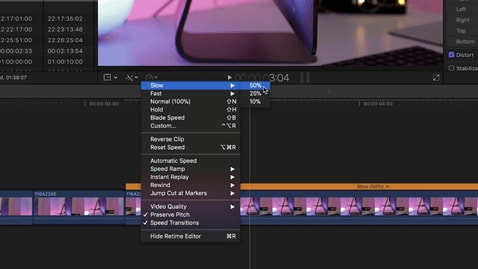
- You will see multiple options to slow down the speed of your clip
- The smaller number will slow down your footage
- To apply custom retiming amounts, again click on the Retiming button and select the Custom option
- Custom the speed of your clip over 100% or less than 100% as you want
- After selecting a value, your selected clip will become longer on the timeline.
Step 4: Adopt Film Grain to Make Film-look Videos
Film grain overlays give your videos vintage and cinematic look. Follow these steps to use these film grains in Final Cut Pro X:
- Import your footage and film grains downloaded from the internet and layer them into your timeline
- Place the film grain on top of your clip
- Select the clip and go to the FCPX blend mode dropdown menu located on the top-right of your screen
- Click on the Overlay and adjust the opacity of the film grain overlay as required.
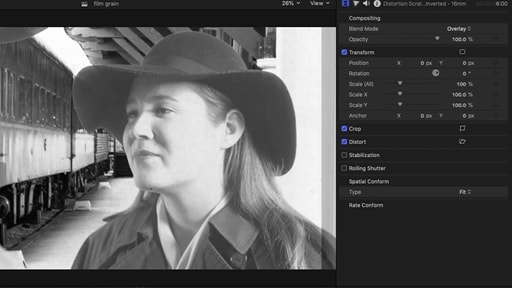
Part 3: What Other Factors Contribute to Film-Look Videos
While making cinematic-look videos, also considering the following factors:
Framing
While filming, one must be aware of the emotion to be captured in the frame. For this purpose, follow the “Rule of Thirds,” which means to divide your short into three horizontal and vertical sections and select the third shot to produce some effect.
Tilt Shift
Instead of shooting your clips with a UHD camera, you can add cinematic effect with the Tilt-shift feature by setting the focus of your video. For this purpose, right-click on the video, select Power Tool and check the box with the option Apply Tilt-shift to the clip. Use the slider to adjust the focus.
Background Music
Cinematic clips without background music seem to be unexciting and boring. Adding melodious background music makes your videos look more professional and enjoyable. You can add default music or your favorite music downloaded from the internet by clicking on the Music tab.
Titles and Subtitles
Adding subtitles to your videos can make them understandable for viewers who speak a different language. Click on Text/Credit in Filmora and select Subtitles to add subtitles to your video.
Part 4: How to Add Cinematic Look to Your Footage in Easy Ways
Filmora is an advanced video editing tool developed by Wondershare. Its user-friendly and easy-to-understand interface makes it popular among beginners as well as professionals. And the best thing about Filmora is that the editor provides rich options of presets, effects, and filters to add a film look to your video.
Here’s how you can add a cinematic look to your footage with Filmora.
1, choose Effect
2, search for “cinematic” or “film”
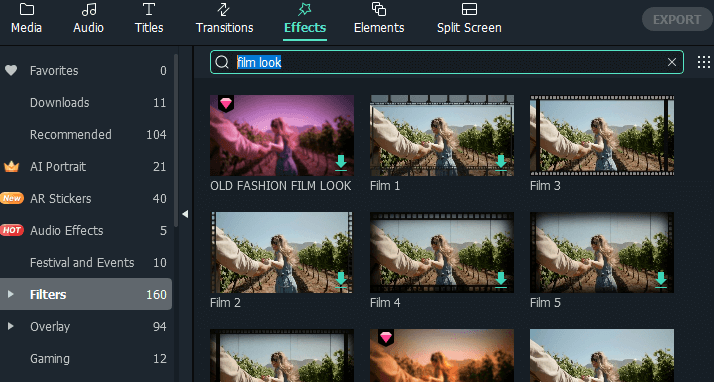
3, drag the effect you like to the timeline
4, done!
Simple steps, right? For more stunning effects and film-look packages, try filmstock !

Conclusion
Get rid of unexciting and dull videos with no animations or effects. It’s time to add a cinematic look to your videos to make them look more professional and elegant.
A variety of tools and applications are available to make cinematic look videos such as Final Cut Pro X and Filmora. Both these software offers advanced video editing features and allow you to make high-resolution cinematic-look videos. You can adjust various aspects of your video such as colors, aesthetics, resolution, motion, frame rate, composition, and camera movements with these two applications.

Caroline Laurent
Caroline Laurent is a writer and a lover of all things video.
Follow @Caroline Laurent
Caroline Laurent
Mar 27, 2024• Proven solutions
Do you enjoy the view of movies? Do you find your videos dull and unexciting? How about giving a cinematic look to your videos?
I bet a lot of editors have been there. However, it won’t take you long to find out that movies are quite different from the video you recorded and edited.
No worries, this article explains why there are differences between self-made videos and movies, as well as simple yet detailed steps to make cinematic look videos with FCPX.
Part 1: Difference between a Cinematic Look and a Normal Video?
The term cinematic is often referred to the black bars or wide-screen frame ratios. Photographers and filmmakers use the term cinematic to describe the look of movies and pictures shot on film.
However, the term has changed its meaning with the advent of digital video and the invention of high-tech devices. With the evolution of the internet across the globe, YouTubers, videographers, and social media influencers have started using this term to describe anything related to cinema and film. In other words, a cinematic look is an unconventional, film-look, and professional appearance of a video that makes a normal clip look elegant and worth watching. See the top 10 movies made by FCPX here.

So, here we draw a line between a normal video and the one with a cinematic look. In the latter, you adjust everything that is directly or indirectly linked to the quality of a video, including but not limited to colors, appearance, light, motion, frame rate, composition, and camera movements.
Resolution refers to the horizontal pixel count such as 2K (2.2 megapixels) or 4K (8.8 megapixels). Similarly, the frame rate defines the number of individual images or frames being displayed on the TV screen per second. The universally accepted film frame rate is 24 FPS, which is used to make high-definition videos. However, most TV broadcasts and shows are recorded at 30fps. See more about FPS here .
Thanks to the advanced video editing tools and applications that have made it easier to capture a cinematic look or make HD cinematic look videos with basic camera setups. If you want to get your desired cinematic look, read the following section.
Part 2: How to Make a Cinematic Look Film Video with FCPX?
The latest features and user-friendly dashboard of Final Cut Pro X allow users (even beginners) to add effects and increase the aesthetics of their videos. Follow these four simple steps to make a cinematic look high-resolution video with Final Cut Pro X.
Step 1: 4K Resolution and Low Frame Rate
To achieve ideal cinematic aesthetics, you need high-quality 4K resolution videos, awesome exposure, the right codec, and lighting. Hence, to start with, capture a high-quality 4K Canon RAW shot with the latest high-tech Canon Log 2 camera. You can also use other devices and choose different codecs and color profiles to get the best color grade.

Step 2: Color Grading and Color Correction
After importing your footage, get ready for color corrections to address issues like conversions for LOG formats through white balance adjustments. Color corrections normalize the color of HD videos into a standard format. Here’s how you can do this:
- Go to the Inspector Panel and select the Extended Function
- Select the C-Log 2 conversion LUT

- Make minor exposure and white balance adjustments as per your scope
- Select the Color Wheels and Color Mask features to custom select specific areas and colors
- Adjust your color grade according to your requirements
- Use Color Masking to improve the shadow’s appearance and warm-up mid-tones
- You will get a strong color contrast in your footage.
Step 3: Use Slow Motion at the Right Timing
Final Cut Pro X allows its users to make both constant and variable speed changes without disturbing the audio’s pitch. By using slow-motion effects at the right timing, you can make your videos adorable and give them a cinematic look.
- Select your video and click on the Retiming button
- Tap on the Slow section

- You will see multiple options to slow down the speed of your clip
- The smaller number will slow down your footage
- To apply custom retiming amounts, again click on the Retiming button and select the Custom option
- Custom the speed of your clip over 100% or less than 100% as you want
- After selecting a value, your selected clip will become longer on the timeline.
Step 4: Adopt Film Grain to Make Film-look Videos
Film grain overlays give your videos vintage and cinematic look. Follow these steps to use these film grains in Final Cut Pro X:
- Import your footage and film grains downloaded from the internet and layer them into your timeline
- Place the film grain on top of your clip
- Select the clip and go to the FCPX blend mode dropdown menu located on the top-right of your screen
- Click on the Overlay and adjust the opacity of the film grain overlay as required.

Part 3: What Other Factors Contribute to Film-Look Videos
While making cinematic-look videos, also considering the following factors:
Framing
While filming, one must be aware of the emotion to be captured in the frame. For this purpose, follow the “Rule of Thirds,” which means to divide your short into three horizontal and vertical sections and select the third shot to produce some effect.
Tilt Shift
Instead of shooting your clips with a UHD camera, you can add cinematic effect with the Tilt-shift feature by setting the focus of your video. For this purpose, right-click on the video, select Power Tool and check the box with the option Apply Tilt-shift to the clip. Use the slider to adjust the focus.
Background Music
Cinematic clips without background music seem to be unexciting and boring. Adding melodious background music makes your videos look more professional and enjoyable. You can add default music or your favorite music downloaded from the internet by clicking on the Music tab.
Titles and Subtitles
Adding subtitles to your videos can make them understandable for viewers who speak a different language. Click on Text/Credit in Filmora and select Subtitles to add subtitles to your video.
Part 4: How to Add Cinematic Look to Your Footage in Easy Ways
Filmora is an advanced video editing tool developed by Wondershare. Its user-friendly and easy-to-understand interface makes it popular among beginners as well as professionals. And the best thing about Filmora is that the editor provides rich options of presets, effects, and filters to add a film look to your video.
Here’s how you can add a cinematic look to your footage with Filmora.
1, choose Effect
2, search for “cinematic” or “film”

3, drag the effect you like to the timeline
4, done!
Simple steps, right? For more stunning effects and film-look packages, try filmstock !

Conclusion
Get rid of unexciting and dull videos with no animations or effects. It’s time to add a cinematic look to your videos to make them look more professional and elegant.
A variety of tools and applications are available to make cinematic look videos such as Final Cut Pro X and Filmora. Both these software offers advanced video editing features and allow you to make high-resolution cinematic-look videos. You can adjust various aspects of your video such as colors, aesthetics, resolution, motion, frame rate, composition, and camera movements with these two applications.

Caroline Laurent
Caroline Laurent is a writer and a lover of all things video.
Follow @Caroline Laurent
Caroline Laurent
Mar 27, 2024• Proven solutions
Do you enjoy the view of movies? Do you find your videos dull and unexciting? How about giving a cinematic look to your videos?
I bet a lot of editors have been there. However, it won’t take you long to find out that movies are quite different from the video you recorded and edited.
No worries, this article explains why there are differences between self-made videos and movies, as well as simple yet detailed steps to make cinematic look videos with FCPX.
Part 1: Difference between a Cinematic Look and a Normal Video?
The term cinematic is often referred to the black bars or wide-screen frame ratios. Photographers and filmmakers use the term cinematic to describe the look of movies and pictures shot on film.
However, the term has changed its meaning with the advent of digital video and the invention of high-tech devices. With the evolution of the internet across the globe, YouTubers, videographers, and social media influencers have started using this term to describe anything related to cinema and film. In other words, a cinematic look is an unconventional, film-look, and professional appearance of a video that makes a normal clip look elegant and worth watching. See the top 10 movies made by FCPX here.

So, here we draw a line between a normal video and the one with a cinematic look. In the latter, you adjust everything that is directly or indirectly linked to the quality of a video, including but not limited to colors, appearance, light, motion, frame rate, composition, and camera movements.
Resolution refers to the horizontal pixel count such as 2K (2.2 megapixels) or 4K (8.8 megapixels). Similarly, the frame rate defines the number of individual images or frames being displayed on the TV screen per second. The universally accepted film frame rate is 24 FPS, which is used to make high-definition videos. However, most TV broadcasts and shows are recorded at 30fps. See more about FPS here .
Thanks to the advanced video editing tools and applications that have made it easier to capture a cinematic look or make HD cinematic look videos with basic camera setups. If you want to get your desired cinematic look, read the following section.
Part 2: How to Make a Cinematic Look Film Video with FCPX?
The latest features and user-friendly dashboard of Final Cut Pro X allow users (even beginners) to add effects and increase the aesthetics of their videos. Follow these four simple steps to make a cinematic look high-resolution video with Final Cut Pro X.
Step 1: 4K Resolution and Low Frame Rate
To achieve ideal cinematic aesthetics, you need high-quality 4K resolution videos, awesome exposure, the right codec, and lighting. Hence, to start with, capture a high-quality 4K Canon RAW shot with the latest high-tech Canon Log 2 camera. You can also use other devices and choose different codecs and color profiles to get the best color grade.

Step 2: Color Grading and Color Correction
After importing your footage, get ready for color corrections to address issues like conversions for LOG formats through white balance adjustments. Color corrections normalize the color of HD videos into a standard format. Here’s how you can do this:
- Go to the Inspector Panel and select the Extended Function
- Select the C-Log 2 conversion LUT

- Make minor exposure and white balance adjustments as per your scope
- Select the Color Wheels and Color Mask features to custom select specific areas and colors
- Adjust your color grade according to your requirements
- Use Color Masking to improve the shadow’s appearance and warm-up mid-tones
- You will get a strong color contrast in your footage.
Step 3: Use Slow Motion at the Right Timing
Final Cut Pro X allows its users to make both constant and variable speed changes without disturbing the audio’s pitch. By using slow-motion effects at the right timing, you can make your videos adorable and give them a cinematic look.
- Select your video and click on the Retiming button
- Tap on the Slow section

- You will see multiple options to slow down the speed of your clip
- The smaller number will slow down your footage
- To apply custom retiming amounts, again click on the Retiming button and select the Custom option
- Custom the speed of your clip over 100% or less than 100% as you want
- After selecting a value, your selected clip will become longer on the timeline.
Step 4: Adopt Film Grain to Make Film-look Videos
Film grain overlays give your videos vintage and cinematic look. Follow these steps to use these film grains in Final Cut Pro X:
- Import your footage and film grains downloaded from the internet and layer them into your timeline
- Place the film grain on top of your clip
- Select the clip and go to the FCPX blend mode dropdown menu located on the top-right of your screen
- Click on the Overlay and adjust the opacity of the film grain overlay as required.

Part 3: What Other Factors Contribute to Film-Look Videos
While making cinematic-look videos, also considering the following factors:
Framing
While filming, one must be aware of the emotion to be captured in the frame. For this purpose, follow the “Rule of Thirds,” which means to divide your short into three horizontal and vertical sections and select the third shot to produce some effect.
Tilt Shift
Instead of shooting your clips with a UHD camera, you can add cinematic effect with the Tilt-shift feature by setting the focus of your video. For this purpose, right-click on the video, select Power Tool and check the box with the option Apply Tilt-shift to the clip. Use the slider to adjust the focus.
Background Music
Cinematic clips without background music seem to be unexciting and boring. Adding melodious background music makes your videos look more professional and enjoyable. You can add default music or your favorite music downloaded from the internet by clicking on the Music tab.
Titles and Subtitles
Adding subtitles to your videos can make them understandable for viewers who speak a different language. Click on Text/Credit in Filmora and select Subtitles to add subtitles to your video.
Part 4: How to Add Cinematic Look to Your Footage in Easy Ways
Filmora is an advanced video editing tool developed by Wondershare. Its user-friendly and easy-to-understand interface makes it popular among beginners as well as professionals. And the best thing about Filmora is that the editor provides rich options of presets, effects, and filters to add a film look to your video.
Here’s how you can add a cinematic look to your footage with Filmora.
1, choose Effect
2, search for “cinematic” or “film”

3, drag the effect you like to the timeline
4, done!
Simple steps, right? For more stunning effects and film-look packages, try filmstock !

Conclusion
Get rid of unexciting and dull videos with no animations or effects. It’s time to add a cinematic look to your videos to make them look more professional and elegant.
A variety of tools and applications are available to make cinematic look videos such as Final Cut Pro X and Filmora. Both these software offers advanced video editing features and allow you to make high-resolution cinematic-look videos. You can adjust various aspects of your video such as colors, aesthetics, resolution, motion, frame rate, composition, and camera movements with these two applications.

Caroline Laurent
Caroline Laurent is a writer and a lover of all things video.
Follow @Caroline Laurent
Caroline Laurent
Mar 27, 2024• Proven solutions
Do you enjoy the view of movies? Do you find your videos dull and unexciting? How about giving a cinematic look to your videos?
I bet a lot of editors have been there. However, it won’t take you long to find out that movies are quite different from the video you recorded and edited.
No worries, this article explains why there are differences between self-made videos and movies, as well as simple yet detailed steps to make cinematic look videos with FCPX.
Part 1: Difference between a Cinematic Look and a Normal Video?
The term cinematic is often referred to the black bars or wide-screen frame ratios. Photographers and filmmakers use the term cinematic to describe the look of movies and pictures shot on film.
However, the term has changed its meaning with the advent of digital video and the invention of high-tech devices. With the evolution of the internet across the globe, YouTubers, videographers, and social media influencers have started using this term to describe anything related to cinema and film. In other words, a cinematic look is an unconventional, film-look, and professional appearance of a video that makes a normal clip look elegant and worth watching. See the top 10 movies made by FCPX here.

So, here we draw a line between a normal video and the one with a cinematic look. In the latter, you adjust everything that is directly or indirectly linked to the quality of a video, including but not limited to colors, appearance, light, motion, frame rate, composition, and camera movements.
Resolution refers to the horizontal pixel count such as 2K (2.2 megapixels) or 4K (8.8 megapixels). Similarly, the frame rate defines the number of individual images or frames being displayed on the TV screen per second. The universally accepted film frame rate is 24 FPS, which is used to make high-definition videos. However, most TV broadcasts and shows are recorded at 30fps. See more about FPS here .
Thanks to the advanced video editing tools and applications that have made it easier to capture a cinematic look or make HD cinematic look videos with basic camera setups. If you want to get your desired cinematic look, read the following section.
Part 2: How to Make a Cinematic Look Film Video with FCPX?
The latest features and user-friendly dashboard of Final Cut Pro X allow users (even beginners) to add effects and increase the aesthetics of their videos. Follow these four simple steps to make a cinematic look high-resolution video with Final Cut Pro X.
Step 1: 4K Resolution and Low Frame Rate
To achieve ideal cinematic aesthetics, you need high-quality 4K resolution videos, awesome exposure, the right codec, and lighting. Hence, to start with, capture a high-quality 4K Canon RAW shot with the latest high-tech Canon Log 2 camera. You can also use other devices and choose different codecs and color profiles to get the best color grade.

Step 2: Color Grading and Color Correction
After importing your footage, get ready for color corrections to address issues like conversions for LOG formats through white balance adjustments. Color corrections normalize the color of HD videos into a standard format. Here’s how you can do this:
- Go to the Inspector Panel and select the Extended Function
- Select the C-Log 2 conversion LUT

- Make minor exposure and white balance adjustments as per your scope
- Select the Color Wheels and Color Mask features to custom select specific areas and colors
- Adjust your color grade according to your requirements
- Use Color Masking to improve the shadow’s appearance and warm-up mid-tones
- You will get a strong color contrast in your footage.
Step 3: Use Slow Motion at the Right Timing
Final Cut Pro X allows its users to make both constant and variable speed changes without disturbing the audio’s pitch. By using slow-motion effects at the right timing, you can make your videos adorable and give them a cinematic look.
- Select your video and click on the Retiming button
- Tap on the Slow section

- You will see multiple options to slow down the speed of your clip
- The smaller number will slow down your footage
- To apply custom retiming amounts, again click on the Retiming button and select the Custom option
- Custom the speed of your clip over 100% or less than 100% as you want
- After selecting a value, your selected clip will become longer on the timeline.
Step 4: Adopt Film Grain to Make Film-look Videos
Film grain overlays give your videos vintage and cinematic look. Follow these steps to use these film grains in Final Cut Pro X:
- Import your footage and film grains downloaded from the internet and layer them into your timeline
- Place the film grain on top of your clip
- Select the clip and go to the FCPX blend mode dropdown menu located on the top-right of your screen
- Click on the Overlay and adjust the opacity of the film grain overlay as required.

Part 3: What Other Factors Contribute to Film-Look Videos
While making cinematic-look videos, also considering the following factors:
Framing
While filming, one must be aware of the emotion to be captured in the frame. For this purpose, follow the “Rule of Thirds,” which means to divide your short into three horizontal and vertical sections and select the third shot to produce some effect.
Tilt Shift
Instead of shooting your clips with a UHD camera, you can add cinematic effect with the Tilt-shift feature by setting the focus of your video. For this purpose, right-click on the video, select Power Tool and check the box with the option Apply Tilt-shift to the clip. Use the slider to adjust the focus.
Background Music
Cinematic clips without background music seem to be unexciting and boring. Adding melodious background music makes your videos look more professional and enjoyable. You can add default music or your favorite music downloaded from the internet by clicking on the Music tab.
Titles and Subtitles
Adding subtitles to your videos can make them understandable for viewers who speak a different language. Click on Text/Credit in Filmora and select Subtitles to add subtitles to your video.
Part 4: How to Add Cinematic Look to Your Footage in Easy Ways
Filmora is an advanced video editing tool developed by Wondershare. Its user-friendly and easy-to-understand interface makes it popular among beginners as well as professionals. And the best thing about Filmora is that the editor provides rich options of presets, effects, and filters to add a film look to your video.
Here’s how you can add a cinematic look to your footage with Filmora.
1, choose Effect
2, search for “cinematic” or “film”

3, drag the effect you like to the timeline
4, done!
Simple steps, right? For more stunning effects and film-look packages, try filmstock !

Conclusion
Get rid of unexciting and dull videos with no animations or effects. It’s time to add a cinematic look to your videos to make them look more professional and elegant.
A variety of tools and applications are available to make cinematic look videos such as Final Cut Pro X and Filmora. Both these software offers advanced video editing features and allow you to make high-resolution cinematic-look videos. You can adjust various aspects of your video such as colors, aesthetics, resolution, motion, frame rate, composition, and camera movements with these two applications.

Caroline Laurent
Caroline Laurent is a writer and a lover of all things video.
Follow @Caroline Laurent
Also read:
- Updated Get Rid of TikTok Logos Best Free Watermark Removers Online
- In 2024, The Ultimate List 10 Best Free and Paid Android Video Editing Apps 2023
- 2024 Approved The Art of Slow Motion How to Create Stunning Videos on Kapwing
- Updated In 2024, Final Cut Pro Tutorial Changing Aspect Ratio for Perfect Videos
- In 2024, The Best Online Video Editors for Vertical Format Videos
- Blur Faces Like a Pro Best Free Apps for Anonymous Media for 2024
- Updated 6 Essential Tools for Creating Engaging Movie Introduction Videos for 2024
- 10 Powerful Video Editing Software Alternatives to Final Cut Pro X for 2024
- In 2024, Best Animation Software for Education A 2023 Review
- Updated 2024 Approved Video Formatting Made Easy Change Shape, Size, and Aspect Ratio
- Updated In 2024, Loop It! Best Free GIF Makers for Endless Animation
- New Best Neon Sign Makers Online Top Picks for DIY Designers for 2024
- New 2024 Approved Transform Your Memories Video Editing Secrets for Unforgettable Home Movies
- Updated In 2024, Discover the Best Top 10 Public Domain Image Websites 2023
- 2024 Approved Upload PS4 Screenshots to Social Media A Beginners Tutorial
- New Get the Job Done Top MP3 Conversion Software for Mac
- New Accelerate Your Videos A QuickTime Player Guide for 2024
- Updated In 2024, S Most Popular Free Video Invitation Maker Websites
- New 2024 Approved Cut Your Videos for Free The Top 5 Tools We Love
- 2024 Approved Make Videos on Apple Mac Computer with the Best Video Maker for Mac
- Updated The Ultimate Guide to Deleting TikTok Watermarks Online for 2024
- In 2024, How To Unlock Stolen Apple iPhone XR In Different Conditionsin | Dr.fone
- Updated In 2024, Change Video Speed with FFmpeg
- Best Android Data Recovery - undelete lost call logs from Realme Narzo N55
- In 2024, How to Bypass Google FRP Lock from Vivo Y77t Devices
- How To Unbrick a Dead Sony Xperia 5 V | Dr.fone
- Easy steps to recover deleted videos from Yuva 2
- In 2024, Complete Tutorial to Use VPNa to Fake GPS Location On Apple iPhone 13 mini | Dr.fone
- Updated Edit On-the-Go Top Mobile Video Editing Apps
- How to Unlock iPhone 7 Plus?
- Quick Fixes for Why Is My Itel A05s Black and White | Dr.fone
- Fixed Excel 2007 Found a Problem with One or more Formula
- In 2024, Different Methods To Unlock Your Apple iPhone 13
- In 2024, Various Methods to Transfer Pictures from Apple iPhone X to PC | Dr.fone
- In 2024, Best 3 Vivo X Flip Emulator for Mac to Run Your Wanted Android Apps | Dr.fone
- New In 2024, How to Create a Slideshow on iPhone
- New The Ultimate Wedding Videography Checklist
- How to Remove Forgotten PIN Of Your Xiaomi 13 Ultra
- How to Flash Dead ZTE Nubia Z60 Ultra Safely | Dr.fone
- Top 10 Fingerprint Lock Apps to Lock Your Xiaomi Redmi Note 12 Pro+ 5G Phone
- In 2024, How to Create Cinematic Style Videos?
- How to Use Pokémon Emerald Master Ball Cheat On Oppo Reno 10 Pro+ 5G | Dr.fone
- Title: Updated 2024 Approved S Top-Rated Free AVI Video Rotation Software Revealed
- Author: Amelia
- Created at : 2024-04-29 19:51:42
- Updated at : 2024-04-30 19:51:42
- Link: https://ai-driven-video-production.techidaily.com/updated-2024-approved-s-top-rated-free-avi-video-rotation-software-revealed/
- License: This work is licensed under CC BY-NC-SA 4.0.


